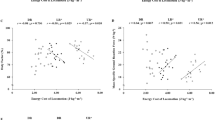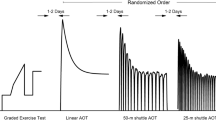Abstract
Purpose
To examine the effects of the world’s most challenging mountain ultra-marathon (Tor des Géants® 2012) on the energy cost of three types of locomotion (cycling, level and uphill running) and running kinematics.
Methods
Before (pre-) and immediately after (post-) the competition, a group of ten male experienced ultra-marathon runners performed in random order three submaximal 4-min exercise trials: cycling at a power of 1.5 W kg−1 body mass; level running at 9 km h−1 and uphill running at 6 km h−1 at an inclination of +15 % on a motorized treadmill. Two video cameras recorded running mechanics at different sampling rates.
Results
Between pre- and post-, the uphill-running energy cost decreased by 13.8 % (P = 0.004); no change was noted in the energy cost of level running or cycling (NS). There was an increase in contact time (+10.3 %, P = 0.019) and duty factor (+8.1 %, P = 0.001) and a decrease in swing time (−6.4 %, P = 0.008) in the uphill-running condition.
Conclusion
After this extreme mountain ultra-marathon, the subjects modified only their uphill-running patterns for a more economical step mechanics.


Similar content being viewed by others
Abbreviations
- θ A (°):
-
Ankle angle
- \(\dot{V}\)CO2 (L min−1):
-
Carbon dioxide output
- t c (s):
-
Contact time
- CT (s):
-
Cycle time
- DF (%):
-
Duty factor
- EC:
-
End of contact
- C cycl (kJ L−1):
-
Energy cost of cycling
- C r (J m−1 kg−1):
-
Energy cost of running
- MUM:
-
Extreme mountain ultra-marathon
- θ F (°):
-
Foot angle
- GE (%):
-
Gross efficiency
- IC:
-
Initial contact
- θ K (°):
-
Knee angle
- \(\dot{W}\) vert (W kg−1):
-
Mechanical work rate
- \(\dot{V}\)O2 (L min−1):
-
Oxygen uptake
- \(\dot{V}\)E (L min−1):
-
Pulmonary ventilation
- t −1c (s−1):
-
Rate of force application
- RER:
-
Respiratory exchange ratio
- θ L (°):
-
Shank angle
- SF (Hz):
-
Stride frequency
- SL (m):
-
Stride length
- t s (s):
-
Swing time
- θ T (°):
-
Thigh angle
- \(\dot{V}\)E/\(\dot{V}\)CO2 :
-
Ventilatory equivalent ratio for carbon dioxide
- \(\dot{V}\)E/\(\dot{V}\)O2 :
-
Ventilatory equivalent ratio for oxygen
References
Abbiss CR, Laursen PB (2008) Describing and understanding pacing strategies during athletic competition. Sports Med 38:239–252
Bijker KE, De Groot G, Hollander AP (2001) Delta efficiencies of running and cycling. Med Sci Sports Exerc 33:1546–1551
Bijker KE, de Groot G, Hollander AP (2002) Differences in leg muscle activity during running and cycling in humans. Eur J Appl Physiol 87:556–561
Blickhan R (1989) The spring-mass model for running and hopping. J Biomech 22:1217–1227
Brϋckner JC, Atchou G, Capelli C, Duvallet A, Barrault B, Jousselin E, Rieu M, di Prampero PE (1991) The energy cost of running increases with the distance covered. Eur J Appl Physiol 62:385–389
Cappozzo A, Catani F, Croce UD, Leardini A (1995) Position and orientation in space of bones during movement: anatomical frame definition and determination. Clin Biomech (Bristol, Avon) 10:171–178
Cavanagh PR, Kram R (1985) Mechanical and muscular factors affecting the efficiency of human movement. Med Sci Sports Exerc 17:326–331
Cavanagh PR, Williams KR (1982) The effect of stride length variation on oxygen uptake during distance running. Med Sci Sports Exerc 14:30–35
de Haan A, Lodder MAN, Sargeant AJ (1991) Influence of an active prestretch on fatigue of skeletal muscle. Eur J Appl Physiol 62:268–273
Degache F, Guex K, Fourchet F, Morin JB, Millet GP, Tomazin K, Millet GY (2013) Changes in running mechanics and spring-mass behaviour induced by a 5-h hilly running bout. J Sports Sci 31:299–304
di Prampero PE, Salvadego D, Fusi S, Grassi B (2009) A simple method for assessing the energy cost of running during incremental tests. J Appl Physiol 107:1068–1075
Foissac MJ, Berthollet R, Seux J, Belli A, Millet GY (2008) Effects of hiking pole inertia on energy and muscular costs during uphill walking. Med Sci Sports Exerc 40:1117–1125
Gimenez P, Kerhervé H, Messonnier LA, Féasson L, Millet GY (2013) Changes in the energy cost of running during a 24-h treadmill exercise. Med Sci Sports Exerc 45:1807–1813
Hayes PR, Bowen SJ, Davies EJ (2004) The relationships between local muscular endurance and kinematic changes during a run to exhaustion at vVO2max. J Strength Cond Res 18:898–903
Higham TE, Biewener AA (2008) Integration within and between muscles during terrestrial locomotion: effects of incline and speed. J Exp Biol 211:2303–2316
Hunter I, Smith GA (2007) Preferred and optimal stride frequency, stiffness and economy: changes with fatigue during a 1-h high-intensity run. Eur J Appl Physiol 100:653–661
Knechtle B (2012) Ultramarathon runners: nature or nurture? Int J Sports Physiol Perform 7:310–312
Komi PV (2000) Stretch-shortening cycle: a powerful model to study normal and fatigued muscle. J Biomech 33:1197–1206
Kyröläinen H, Pullinen T, Candau R, Avela J, Huttunen P, Komi PV (2000) Effects of marathon running economy and kinematics. Eur J Appl Physiol 82:297–304
Lazzer S, Salvadego D, Rejc E, Buglione A, Antonutto G, di Prampero PE (2012) The energetics of ultra-endurance running. Eur J Appl Physiol 112:1709–1715
McMahon TA, Valiant G, Frederick EC (1985) Groucho running. J Appl Physiol 62:2326–2337
Millet GP (2012) Economy is not sacrificed in ultramarathon runners. J Appl Physiol 113:686
Millet GP, Millet GY (2012) Ultramarathon is an outstanding model for the study of adaptive responses to extreme load and stress. BMC Med 10:77
Millet G, Lepers R, Lattier G, Martin V, Babault N, Maffiuletti N (2000) Influence of ultra-long-term fatigue on the oxygen cost of two types of locomotion. Eur J Appl Physiol 83:376–380
Millet GY, Lepers R, Maffiuletti NA, Babault N, Martin V, Lattier G (2002) Alterations of neuromuscular function after an ultramarathon. J Appl Physiol 92:486–492
Millet GP, Vleck VE, Bentley DJ (2009a) Physiological differences between cycling and running. Lessons from triathletes. Sports Med 39:179–206
Millet GY, Morin JB, Degache F, Edouard P, Feasson L, Verney J, Oullion R (2009b) Running from Paris to Beijing: biomechanical and physiological consequences. Eur J Appl Physiol 107:731–738
Millet GY, Banfi JC, Kerherve H, Morin JB, Vincent L, Estrade C, Geyssant A, Feasson L (2011a) Physiological and biological factors associated with a 24 h treadmill ultra-marathon performance. Scand J Med Sci Sports 21:54–61
Millet GY, Tomazin K, Verges S, Vincent C, Bonnefoy R, Boisson RC, Gergele L, Feasson L, Martin V (2011b) Neuromuscular consequences of an extreme mountain ultra-marathon. PLoS One 6:e17059
Millet GY, Hoffman MD, Morin JB (2012) Sacrificing economy to improve running performance–a reality in the ultramarathon? J Appl Physiol 113:507–509
Minetti AE, Ardigò LP, Saibene F (1994) Mechanical determinants of the minimum energy cost of gradient running in humans. J Exp Biol 195:211–225
Minetti AE, Moia C, Roi GS, Susta D, Ferretti G (2002) Energy cost of walking and running at extreme uphill and downhill slopes. J Appl Physiol 93:1039–1046
Morin JB, Tomazin K, Edouard P, Millet GY (2011) Changes in running mechanics and spring-mass behavior induced by a mountain ultra-marathon race. J Biomech 44:1104–1107
Moseley L, Jeukendrup AE (2001) The reliability of cycling efficiency. Med Sci Sports Exerc 33:621–627
Nelson WL (1983) Physical principles for economies of skilled movements. Biol Cybern 46:135–147
Nicol C, Komi PV, Marconnet P (1991a) Effects of marathon fatigue on running kinematics and economy. Scand J Med Sci Sports 1:195–204
Nicol C, Komi PV, Marconnet P (1991b) Fatigue effects of marathon running on neuromuscular performance. Changes in force, integrated electromyographic activity and endurance capacity. Scand J Med Sci Sports 1:18–24
Padulo J, Powell D, Milia R, Ardigò LP (2013) A paradigm of uphill running. PLoS One 8:e69006
Pringle JSM, Carter H, Doust JH, Jones AM (2002) Oxygen uptake kinetics during horizontal and uphill treadmill running in humans. Eur J Appl Physiol 88:163–169
Riley PO, Dicharry J, Franz J, Della Croce U, Wilder RP, Kerrigan DC (2008) A kinematics and kinetic comparison of overground and treadmill running. Med Sci Sports Exerc 40:1093–1100
Roberts TJ, Belliveau RA (2005) Sources of mechanical power for uphill running in humans. J Exp Biol 208:1963–1970
Roberts TJ, Kram R, Weyand PG, Taylor CR (1998) Energetics of bipedal running. I. Metabolic cost of generating force. J Exp Biol 201:2745–2751
Rubenson J, Heliams DB, Lloyd DG, Fournier PA (2004) Gait selection in the ostrich: mechanical and metabolic characteristics of walking and running with and without an aerial phase. Proc Biol Sci 271:1091–1099
Saugy J, Place N, Millet GY, Degache F, Schena F, Millet GP (2013) Alterations of neuromuscular function after the world’s most challenging mountain ultra-marathon. PLoS One 8:e65596
Schmitt D (2003) Insights into the evolution of human bipedalism from experimental studies of humans and other primates. J Exp Biol 206:1437–1448
Schobersberger W, Wirleitner B, Puschendorf B, Koller A, Villiger B, Frey W, Mair J (1996) Influence of an ultramarathon race at moderate altitude on coagulation and fibrinolysis. Fibrinolysis 10:37–42
Siler WL, Martin PE (1991) Changes in running pattern during a treadmill run to volitional exhaustion: fast versus slower runners. Int J Sport Biomech 7:12–28
Snyder KL, Farley CT (2011) Energetically optimal stride frequency in running: the effects of incline and decline. J Exp Biol 214:2089–2095
Snyder KL, Kram R, Gottschall JS (2012) The role of elastic energy storage and recovery in downhill and uphill running. J Exp Biol 215:2283–2287
Taylor CR, Caldwell SL, Rowntree VJ (1972) Running up and down hills: some consequences of size. Science 178:1096–1097
Vitiello D, Rupp T, Bussière JL, Robach P, Polge A, Millet GY, Nottin S (2013) Myocardial damages and left and right ventricular strains after an extreme mountain ultra-long duration exercise. Int J Cardiol 165:391–392
Williams KR (1985) Biomechanics of running. Exerc Sport Sci Rev 13:389–441
Winter DA (2009) The biomechanics and motor control of human gait: normal, elderly and pathological, 4th edn. Wiley, Hoboken
Acknowledgments
The authors wish to thank the subjects involved in the present study for their participation, especially during the test sessions in the fatigue condition. We would also like to express our gratitude to Aurelio Marguerettaz, the Regione Autonoma della Valle d’Aosta, the Tor de Géants® Organizing Committee, the Courmayeur Trailers, and Maurizio Capolupo. We thank also Kenneth A. Britsch for checking the manuscript for English.
Author information
Authors and Affiliations
Corresponding author
Additional information
Communicated by Jean-René Lacour.
Rights and permissions
About this article
Cite this article
Vernillo, G., Savoldelli, A., Zignoli, A. et al. Influence of the world’s most challenging mountain ultra-marathon on energy cost and running mechanics. Eur J Appl Physiol 114, 929–939 (2014). https://doi.org/10.1007/s00421-014-2824-y
Received:
Accepted:
Published:
Issue Date:
DOI: https://doi.org/10.1007/s00421-014-2824-y




